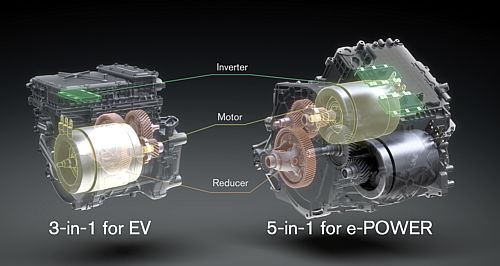Make / Model Search
News - NissanNissan forecasts cheaper EVs by 2026Modular electric drivetrains to slash production price of e-Power to same as ICEs13 Mar 2023 By NEIL DOWLING NISSAN has this week detailed how its new modular EV components will slash development and production costs by as much as 30 per cent over the next three years, bringing the price of its e-Power (electric) models in line with those powered by internal combustion engines.
The Japanese manufacturer says its X-in-1 strategy – with 3-in-1 being modular motor, inverter and reducer, and 5-in-1 adding generator and increaser – will work alongside internal-combustion engines in playing a crucial long-term role in the brand’s future.
Speaking to media in a webinar address from Tokyo, four key Nissan executive engineers outlined how the ongoing e-Power program – which uses ICEs powering onboard generators for electric motors – and EV vehicles will be produced side-by-side.
The executive team also highlighted how the development of two additional electrified powerplant developments and state-of-art solid-state battery production will take place over the next five years.
Nissan said it will expand its e-Power offerings to a broader range of models, suggesting some of the dozen models already on offer in Japan could be sold Down Under. This includes the prospect of electrified commercial vehicles, including utes.
The firm says the benefit of e-Power over battery electric (BEV) power is the potential for longer range and freedom from charging stations – ideal for regional Australia. But having two powerplants (ICE and EV) aboard the same vehicle is currently rather expensive.
However, according to Nissan vice president of powertrain, Shunichi Inamijima, parts sharing can help to make e-Power models as affordable as a four-cylinder ICE vehicle within is little as two or three years.
“The future cost of conventional (ICE) engines are expected to rise in order to comply with more and more stringent emission regulations and fuel efficiency demands,” said Mr Inamijima.
“On the other hand, future technical innovations in battery and e-Power will effectively reduce the cost to parity with ICE vehicle cost by 2026.”
He said that battery innovation “such as solid-state batteries” and the cost reduction of Nissan’s new modular and component-sharing program “will end cost disparity” between vehicles on the production line.
Nissan is building its solid-state battery (SSB) plant in Japan with a pilot production set for 2024 and initial production in 2025. It aims to put the batteries into a mass-produced Nissan model by 2028.
SSB advantages are claimed to be a tripling of charging speeds – close to a constant 400kW regardless of ambient temperature – with double the energy density of a comparable size lithium-ion battery, all at about half of the cost.
This means future EVs will be lighter, have a longer range, be able to charge much more quickly and, with the batteries being cheaper, potentially cheaper as well.
Nissan also said it was also continuing work on developing a new generation of cobalt-free lithium-ion batteries – which are expected to be 65 per cent cheaper than comparable Li-ion batteries with cobalt – and plans to release these within two years.
By 2028, it planned to offer SSB units in its production EVs, the new cobalt-free Li-ion batteries and a cheaper lithium-iron-polymer (LFP) battery with an enhanced power density.
Mr Inamijima said each battery development was designed for different vehicle applications and said an SSB, for example, may not be suitable for e-Power vehicles because of different energy needs, charging regimes and physical sizes.
He said acceptance in Japan for electrified vehicles has reached 52 per cent (i.e., 52 per cent of new Nissan vehicles sold in Japan are either EV, PHEV, HEV or e-Power models).
“Two other major markets which have been highly accepted are the US and Europe. For e-Power, Nissan’s Qashqai became the best seller in 2022 in the UK and Kicks with e-Power launched in Mexico also had strong sales,” he said.
“This shows that in even markets new to e-Power, the power plant has high levels of acceptance.”
In outlining the advantages of e-Power, Mr Inamijima said that aside from the promise of cost parity in production within three years, it offered motorists a “stress-free ultimate driving experience.”
“Only by 100 per cent (electric) motor drive can we realise ultimate driving excitement and aim for zero unconscious stress. Electric drive can bring a new normal driving experience that cannot be experienced by internal-combustion system,” he said.
“By precise and integrated control logics to the motor and brakes, we can provide the desired drivability, confidence at any road condition and comfort for all passengers leading to a jump in driving quality.
“The other perspective to realise is zero unconscious stress – that is, while driving they already recognised stress, such as traffic jam. But unconscious stress accumulated while driving long distances leads drivers and passengers to fatigue or motion sickness.
“For example, frequent shifting between brakes and accelerator, steering correction operation, and unnecessary noise and uncomfortable vibration or shake all play a part in reducing occupant comfort and can affect safety.
“Technologies in motor-driven vehicles can reduce stress and discomfort and is a technical area which will be evolved to realise driving excitement and reduce zero unconscious stress.”  Read more6th of March 2023  Base Nissan Pathfinder given marching ordersPathfinder’s base ST-L grade killed off as sales of Nissan’s large SUV fail to fire16th of February 2023  Nissan X-Trail e-Power on sale from $54K + ORCTwo highly specified electrified Nissan X-Trail variants take on Toyota RAV4 hybrid |
Click to shareNissan articlesResearch Nissan Motor industry news |











Facebook Twitter Instagram